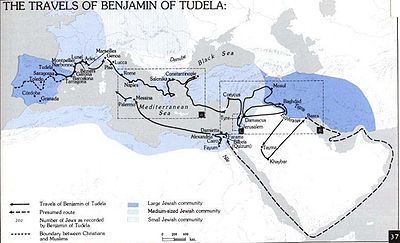
Benjamin of Tudela
About this schools Wikipedia selection
This content from Wikipedia has been selected by SOS Children for suitability in schools around the world. Click here for more information on SOS Children.
Benjamin of Tudela (Binyamin MeTudela) was a medieval Navarrese rabbi and explorer who traveled through Europe, Asia, and Africa in the 12th century. His vivid descriptions of western Asia preceded those of Marco Polo by a hundred years. With his broad education and vast knowledge of languages, Benjamin of Tudela is a major figure in the history of geography and Judaism.
Journey

Benjamin set out on his journey around 1165, in what began as a pilgrimage to the Holy Land. He may have hoped to settle there, but there is controversy about the reasons for his travels. It has been suggested he may have had a commercial motive as well as a religious one. On the other hand, he may have intended to catalogue the Jewish communities on the route to the Holy Land so as to provide a guide to where hospitality may have been found for Jews travelling to the Holy Land. He took the "long road" stopping frequently, meeting people, visiting places, describing occupations and giving a demographic count of Jews in every town and country.
Little is known of his early life, apart from the fact that he was from the Navarrese town of Tudela. Today, a street in the aljama (former Jewish quarter) is named after him. His journey began in the city of Zaragoza, further down the valley of the Ebro, whence he proceeded north to France, and then set sail from the port of Marseilles. After visiting Rome and Constantinople, he set off across Asia, visiting Syria and Palestine before reaching Baghdad. From there he went to Persia, then cut back across the Arabian Peninsula to Egypt and North Africa, returning to the Iberian Peninsula in 1173. In all he visited over 300 cities including Rome, Constantinople, Alexandria, Jerusalem, Damascus, Baghdad, and beyond.
He described his years abroad in a book, The Voyages of Benjamin (מסעות בנימין, Masa'ot Binyamin, also known as ספר המסעות, Sefer ha-Masa'ot, The Book of Travels). This book describes the countries he visited, with an emphasis on the Jewish communities, including their total populations and the names of notable community leaders. He also described the customs of the local population, both Jewish and non-Jewish, with an emphasis on urban life there. There are also detailed descriptions of sites and landmarks he passed along the way, as well as important buildings and marketplaces. Benjamin is noted for not only telling facts, but citing his sources; historians regard him as highly trustworthy.
The Voyages of Benjamin is an important work not only as a description of the Jewish communities, but also as a reliable source about the geography and ethnography of the Middle Ages. As well some modern historians credit Benjamin as giving very accurate descriptions of every-day life in the Middle Ages. Originally written in Hebrew, it was translated in to Latin and later translated into most major European languages, receiving considerable attention in the sixteenth century.
Translations of his work
- Benjamin of Tudela. The Itinerary of Benjamin of Tudela: Travels in the Middle Ages. trans. Joseph Simon. Pangloss Press, 1993. ISBN 0-934710-07-4
- The Itinerary of Benjamin of Tudela. trans. Marcus Nathan Adler. 1907: includes map of route (p. 2) and commentary.
- Works by Benjamin of Tudela at Project Gutenberg
Commemoration
The name Benjamin of Tudela was adopted by a mid-19th century traveler and author, known as Benjamin II.
One of the main works of Mendele Mocher Sforim, a major 19th century Russian Jewish writer, is the 1878 Masoes Benyomen Hashlishi (מסעות בנימין השלישי) (The Wanderings of Benjamin III), which is considered something of a Jewish Don Quixote and whose title is clearly inspired by Benjamin of Tudela's book.
A street in Jerusalem's Rehavia neighbourhood, Rehov Binyamin Metudela (רחוב בנימין מטודלה), is named after him - as is a street in the former Jewish Quarter of his hometown Tudela.
The well-known Israeli poet Nathan Alterman wrote a poem about Benjamin of Tudela, which was set to music by Naomi Shemer and was often heard on the Israeli radio.

